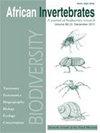Identity of parasitoid wasps (Hymenoptera, Braconidae and Eulophidae) reared from aquatic leaf-mining flies (Diptera, Ephydridae) on invasive Brazilian waterweed Egeria densa in South Africa
IF 1.1
4区 农林科学
Q3 ENTOMOLOGY
引用次数: 3
Abstract
The Brazilian waterweed, Egeria densa Planchon, 1849 (Hydrocharitaceae), is an invasive species in South Africa where it is a host plant for the aquatic leaf-miner Hydrellia egeriae Rodrigues-Junior, 2015 (Ephydridae, Diptera). Efficacy of the biocontrol agent can potentially be affected by parasitoids. Three species of braconid parasitoid wasps were reared from puparia of Hydrellia egeriae. By comparison with the type specimens, these species have been determined to be Ademon lagarosiphonae van Achterberg, 2012 (Braconidae: Opiinae), Chaenusa anervata van Achterberg, 2012 and Chaenusa seminervata van Achterberg, 2012 (Braconidae: Alysiinae: Dacnusini), all previously recorded as parasitoids of an ephydrid dipterous aquatic leaf-miner, Hydrellia lagarosiphon Deeming, 2012, on Lagarosiphon major (Ridley, 1886) Moss ex Wager (Hydrocharitaceae) in South Africa. The chalcidoid, Janicharis africanus Gumovsky & Delvare, 2006 (Eulophidae), was also reared from Hydrellia egeriae and is possibly a hyperparasitoid of the braconids. South Africa is a new country record for J. africanus. We provide comprehensive images of all species including the braconid types and illustrated identification keys to the Afrotropical species of the two braconid genera are also provided. All images and online keys are available on WaspWeb (http://www.waspweb.org).南非入侵的巴西水草Egeria densa上由水生采叶蝇(Diptera,Ephydridae)饲养的寄生蜂(膜翅目、茧蜂科和真蜂科)的身份
巴西水草,Egeria densa Planchon,1849(水藻科),是南非的一种入侵物种,是水生叶潜蝇Hydrellia egeriae Rodrigues Junior,2015(Ephydridae,Diptera)的寄主植物。生物防治剂的效力可能会受到寄生蜂的影响。以埃格海珠的蛹为材料,饲养了三种有刺寄生蜂。通过与模式标本的比较,这些物种已被确定为Ademon lagarosiphae van Achterberg,2012(Braconidae:Opiinae)、Chaenusa anervata van Achtenberg,2012和Chaenusa semervata van Acterberg,2012(Braconidae:Alysinae:Dacnusini,关于Lagarosiphop major(Ridley,1886)南非的Moss ex Wager(水藻科)。chalcidoid,Janicharis africanus Gumovsky&Delvare,2006(Eulophidae),也由Hydrellia egeriae饲养,可能是braconids的一种高脂蛋白。南非是非洲小蠊的新国家记录。我们提供了包括荆棘类型在内的所有物种的综合图像,并提供了两个荆棘属的非营养物种的图解识别钥匙。WaspWeb上提供了所有图像和在线密钥(http://www.waspweb.org)。
本文章由计算机程序翻译,如有差异,请以英文原文为准。
求助全文
约1分钟内获得全文
求助全文
来源期刊

African Invertebrates
生物-动物学
CiteScore
1.00
自引率
0.00%
发文量
6
审稿时长
>12 weeks
期刊介绍:
African Invertebrates is an international peer-reviewed, open-access journal that focuses primarily on the taxonomy, systematics, biogeography, and palaeontology of Afrotropical invertebrates, whether terrestrial, freshwater or marine. Aspects concerning biology, ecology, and conservation may also be considered where these relate to the primary focus areas. Papers dealing solely with biology, ecology, physiology, pests and pest control should be submitted elsewhere.
 求助内容:
求助内容: 应助结果提醒方式:
应助结果提醒方式:


